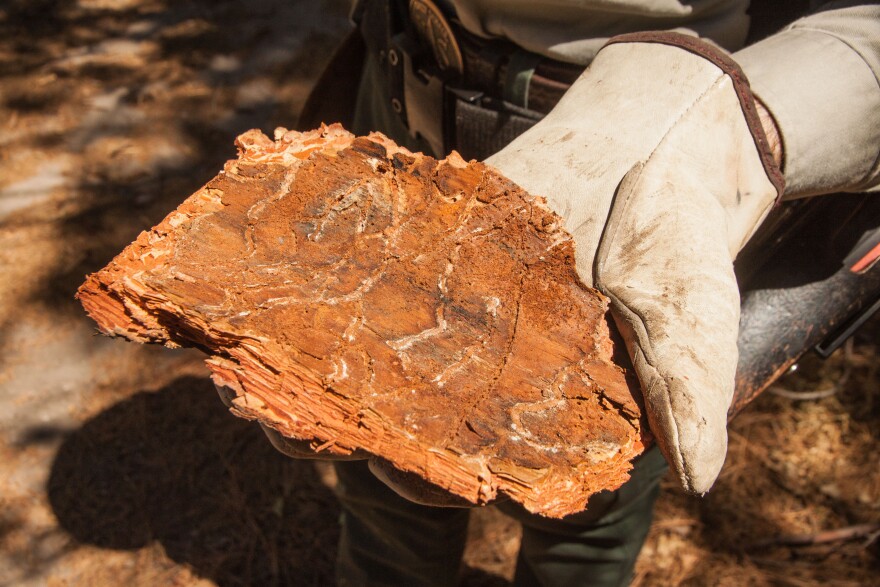This story received a 2017 Golden Mike Award from the Radio Television News Association of Southern California. Read about other winners here.
In the Sierra Nevada, it’s estimated that tens of millions of trees have died as a result of drought, many of which succumbed to infestations from bark beetles. As a result, we’ve been told our risk of wildfire is far higher than normal, but FM89’s Kerry Klein says the science doesn’t necessarily agree.
Gaze across a hillside at 5,000 feet in the Sierra Nevada, and that landscape, usually a wash of green pines, firs and cedars, is probably smudged with reds and browns. “You're looking at, sometimes in areas, 50 percent or more mortality,” says Al Watson, a ranger with Sequoia National Forest—“where, three years ago, there was only a few sporadic types of dead trees here and there.”
The forest service puts the latest death toll at 66 million trees in California alone. And for a state that’s hot, dry, and in its fifth year of drought, Watson says those trees are a danger. “More dead trees in higher concentration mean a lot more fire risk,” he says.
It’s easy to draw a straight line between dead trees and wildfires. After all, Secretary of Agriculture Tom Vilsack has used the words “extreme” and “catastrophic” to articulate the hazard—and wildfire risk was a major reason Governor Brown declared a state of emergency last fall.
But among researchers, there’s some dispute as to how this tree mortality actually influences fire behavior. Many scientific studies have demonstrated no relationship between stands of dead trees and fire severity; some studies even found wildfires are weaker in areas hard-hit by tree die-offs.

So how can these opposing arguments coexist? It’s because the conditions around the dead trees can vary so wildly, says Brian Block, a forester with Sequoia National Forest. He and Watson took me out to the woods near Lake Isabella to survey the damage. Block points out a thick ponderosa pine that succumbed to bark beetles, its needles a reddish brown. “These trees that you see on the landscape that are red and brown, they have a lot of fine needles on them, and they will ignite very easily,” Block says. “Once they start losing all of their fine needles and they basically become tree trunks with a few branches on them that are three inches in diameter, they don't burn very well.”
It turns out that standing trees, even when dead, don’t actually ignite very easily. “Like you're building a fire in your fireplace, you lay the logs all down,” Block continues. “You wouldn't want to stand them all up, because if you put a match to it, you can't get them to light. But if you lay your sticks crossways, there's more surface area, they burn better. Same thing with a standing tree.”
But forests are made up of any combination of trees standing or fallen, with and without needles. So it’s on balance, Block says, that more dead trees are estimated to pose a greater fire risk.
But Chad Hanson, an ecologist with the John Muir Project, a non-profit conservation group, says it’s not true that dead trees increase the risk of wildfire. First off, research doesn’t show that fallen trees are any more flammable than standing ones. “While you do have more woody material on the forest floor, on one hand,” Hanson says, “on the other hand, these downed logs, especially once they start decaying a little bit, they act like giant sponges. They retain and soak up enormous amounts of water on the forest floor.”
Another argument you’re likely to hear is that because of drought, fires are already burning hotter than usual, and that increased intensity will light up those tough-to-burn dead, standing trees. Hanson says, yes, but, “if you've got hotter, drier, windier conditions, then you're generally going to have more intense fire behavior overall. And so, if you've got the conditions that are right for a high-intensity fire patch, the winds really whip up more, it's kind of the peak heat of the day, those trees are going to burn pretty intensely whether they're alive or dead.”
What Hanson’s saying is, the closest indicator of how fast and hot a fire will burn is not whether the trees are dead or alive—it’s the weather. “People are very focused on forest structure, and the density of the forest, and live trees and dead trees,” he says. “Really, the fact is, what the science is telling us is that fires are overwhelmingly weather driven. Hot, dry, windy conditions; that's going to give you more intense fire.”
When it comes down to it, we’re always at risk for wildfires here in California.

Just ask Stan Lung, a long-time resident of Bass Lake, a town whose woody backdrop has been ravaged by drought and bark beetles. He remembers watching the Courtney Fire devour a hill just across the lake in 2014. It was so hot, it didn’t matter if the trees were standing or fallen, alive or dead. “It just rolled down that mountain there like it was a lawn mower; just came rolling down,” he says. “You could just see the trees just explode. That's what they do; they explode and they throw fire out around them. It's scary.”
The 86-year-old has watched PG&E take down scores of towering pine trees that had lived in Bass Lake longer than he has. Five of them were on his property. He was sad to see them go. But he knows that if there’s even the remotest possibility that they put his house in more fire danger than they did when they were alive, cutting them down was worth it.







